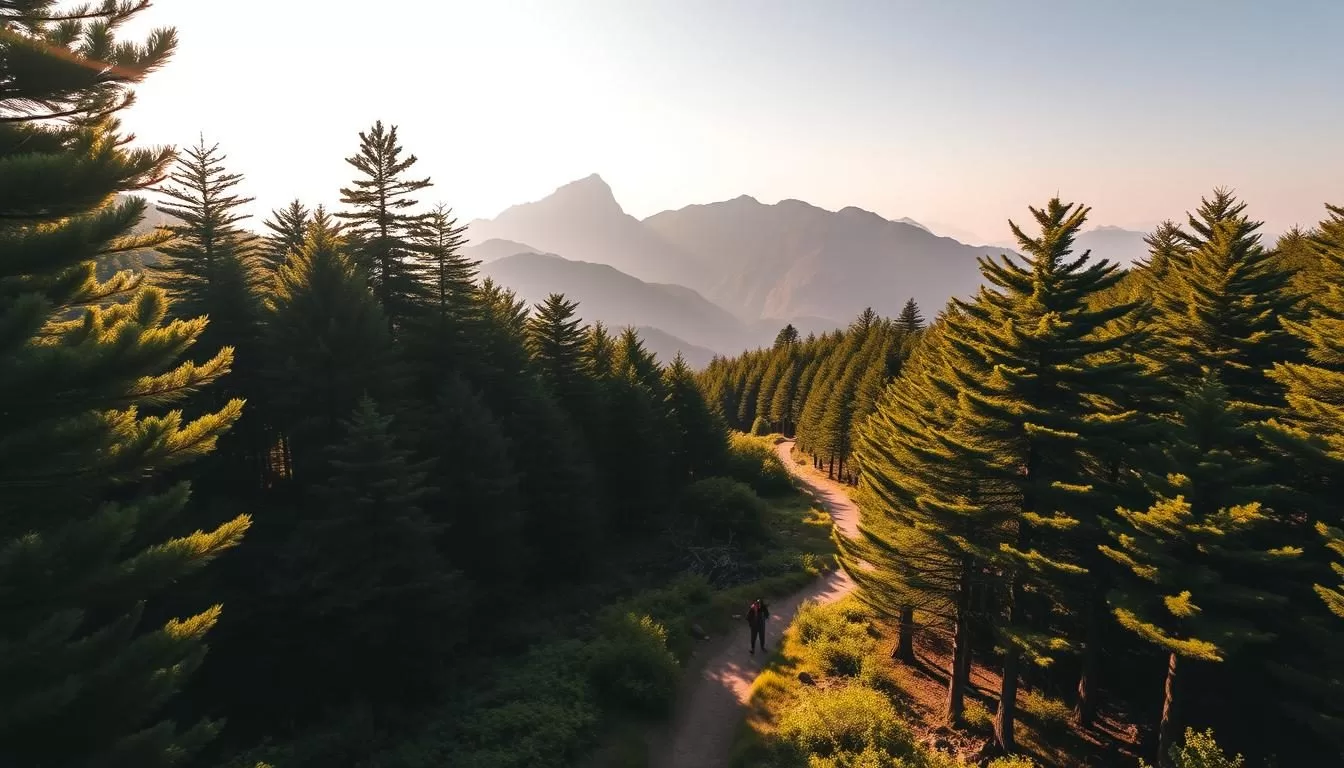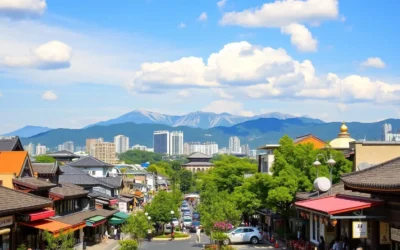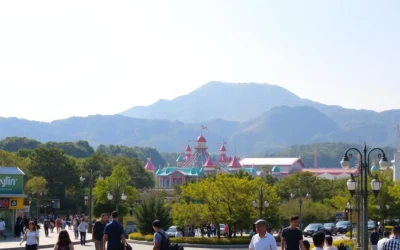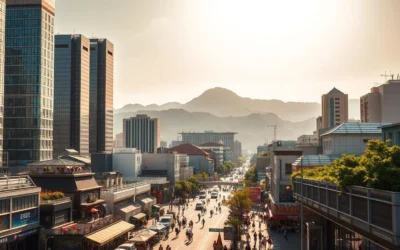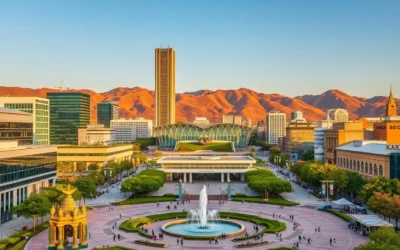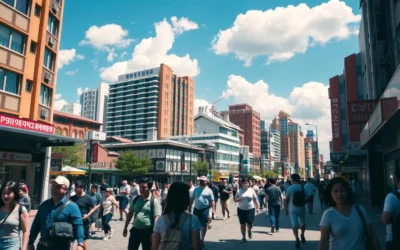Looking for an unforgettable hiking experience? Bukhansan National Park is a must-visit destination for nature lovers and adventure seekers. Known as one of the most visited parks per unit area, it attracts millions of visitors each year.
This park is not just about trails; it’s a blend of stunning landscapes and rich cultural heritage. With multiple entrances, it’s easily accessible from central locations like Myeongdong and Seoul Station. Whether you’re a beginner or an expert hiker, there’s a trail for you.
From the towering Baegundae Peak to serene temple stays, the park offers something for everyone. Get ready to explore its beauty and discover why it’s a favorite among locals and tourists alike.
Overview of Bukhansan National Park
Discover the rich history and natural wonders of Bukhansan National Park. Established in 1983, this iconic area spans a vast region in northern Seoul. It once served as the city’s natural border, offering both protection and beauty.
Park History and Formation
The park’s formation is deeply tied to its geologic and cultural significance. Its granite peaks and lush forests have been a part of Seoul’s landscape for centuries. Ancient fortresses and over 100 temples dot the area, reflecting its historical importance.
Located near the Han River, the park has played a vital role in shaping the surrounding region. Its proximity to the river has influenced both its ecology and its cultural heritage.
Key Statistics and Visitor Insights
Bukhansan National Park attracts around five million visitors annually, earning it a place in the Guinness Book of World Records as the most visited park per unit area. Its diverse ecosystem includes 1,300 plant and animal species, making it a haven for nature enthusiasts.
The Jeongneung Park Information Center is a key resource for visitors. It provides essential details about trails, safety, and the park’s history. Popular routes like the Bukhansanseong Course and Sinseondae Course cater to hikers of all skill levels.
| Statistic | Details |
|---|---|
| Total Area | 79.92 km² |
| Highest Peak | Baegundae (836.5 meters) |
| Number of Temples | Over 100 |
| Annual Visitors | Approximately 5 million |
Whether you’re exploring its trails or learning about its history, Bukhansan National Park offers a unique blend of natural beauty and cultural richness.
How to Get There: Access and Transportation
Planning your visit to this iconic destination? Here’s how to get there. Whether you prefer public transport or driving, reaching this natural haven is simple and convenient.
Public Transport Options
The area is well-connected by an excellent public transportation network. Take the subway to Gupabal Station (Line 3) and then hop on a bus to Bukhansanseong. Look for key bus stops like Jeongneung and Dobong, which are close to the park entrance.
English announcements on buses and subways make navigation easy for international visitors. This ensures a smooth journey to your destination.
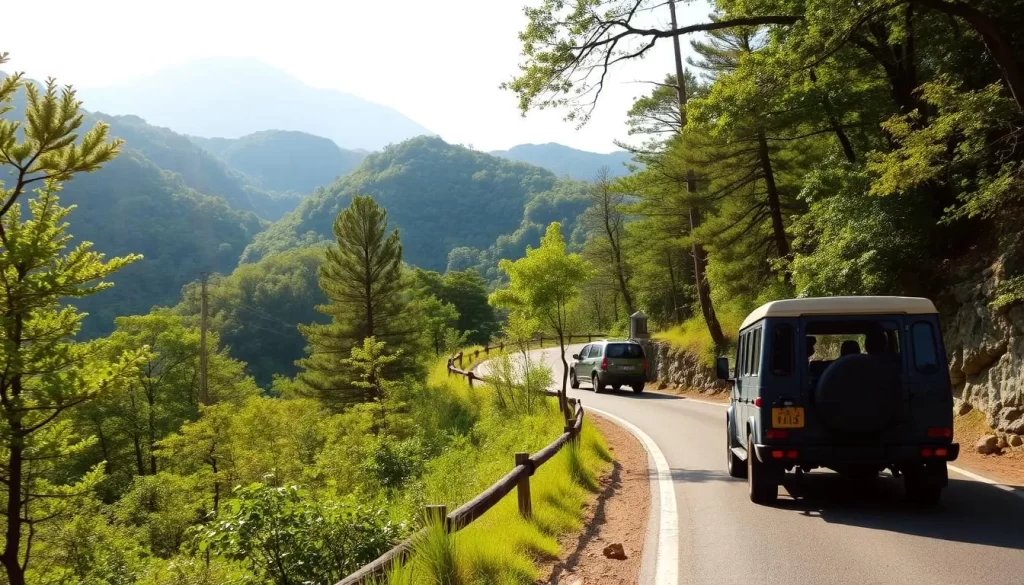
Driving, Parking, and Taxi Tips
If you’re driving, parking is available near major entrances. Arrive early during peak seasons to secure a spot. Taxis are another great option, especially if you’re traveling with gear or in a group.
Follow signs to the nearest park entrance to avoid confusion. Parking fees are reasonable, and taxi drop-off points are clearly marked.
Arrival Guidance at Multiple Entrances
There are several entrances to choose from, including Jeongneung and Dobong Park Information Centers. Each entrance offers unique access points to trails and scenic spots.
Start your adventure at the Bukhansanseong information center for detailed maps and safety tips. This ensures you’re well-prepared for your hike.
Exploring Trails and Hiking Routes
Ready to explore some of the most scenic trails in the region? The area offers a variety of routes, from leisurely walks to challenging climbs. Maps are available at information centers, helping you plan your adventure.
Trail Map and Popular Routes
The extensive network of paths includes options for all fitness levels. Popular routes like the 2.4 km Bogukmun Course are perfect for beginners, while the demanding ascent to Baegundae Peak attracts experienced hikers.
Trail maps highlight key features, such as forest paths and rocky ascents. These maps ensure you stay on track while enjoying the diverse natural beauty of the area.
Difficulty Levels and Recommendations
Whether you’re a beginner or an expert, there’s a route for you. Leisurely hikes like the Bogukmun Course offer scenic views without much effort. For a challenge, try the 5.1 km route to Baegundae Peak.
Always check trail information at the information centers before starting your hike. This ensures you’re prepared for the difficulty level and weather conditions.
With so many options, you’re sure to find a trail that suits your skill level and interests. Happy hiking!
What to Expect: Scenic Views and Natural Beauty
Step into a world where dramatic landscapes and serene beauty come together. This area is a haven for those seeking to connect with nature and escape the hustle of urban life. With its towering granite peaks and pristine streams, it offers an unforgettable experience for every visitor.
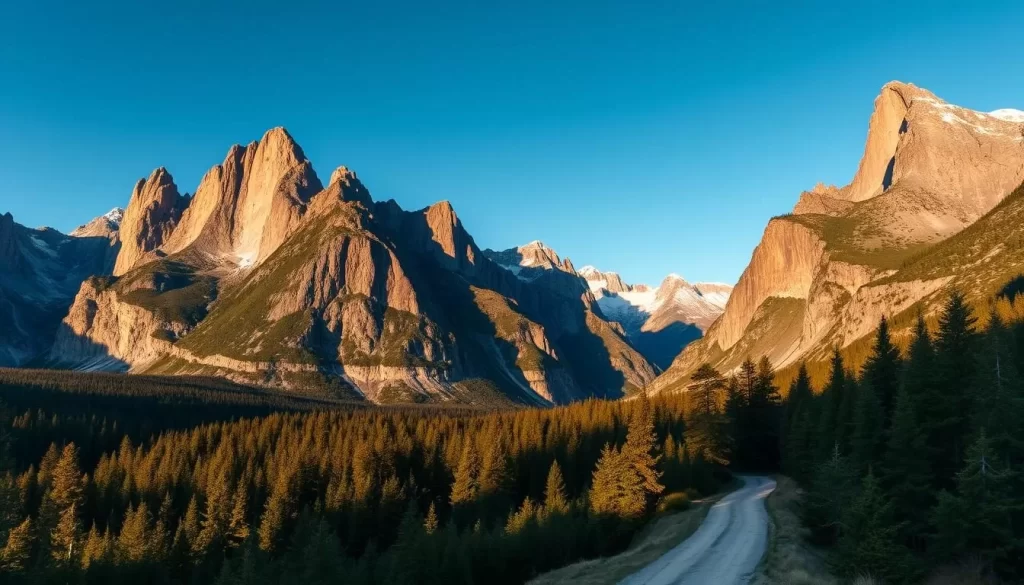
Stunning Landscapes and Granite Peaks
The dramatic granite peaks are the highlight of this region. Rising majestically, they provide breathtaking views that are perfect for photography or simply soaking in the beauty of the surroundings. The hike to the highest point, Baegundae Peak, takes about 2 hours, offering panoramic vistas that are worth the effort.
For a less challenging route, the Dobongsan trail features a 740-meter climb to the Ridgetop peak. This path is ideal for those who want to enjoy the mountain scenery without a strenuous hike.
Flora, Fauna, and Flowing Streams
The area is home to over 3,100 plant and animal species, making it a vibrant natural sanctuary. As you explore, you’ll encounter lush forests, colorful wildflowers, and crystal-clear streams. These elements create a peaceful atmosphere that contrasts sharply with the nearby urban sprawl of Seoul.
Spring and autumn are the best times to visit, as the foliage and blooms add an extra layer of beauty to the landscape. Whether you’re hiking or simply enjoying the scenery, this area offers a truly immersive nature experience.
Cultural and Historical Highlights
Immerse yourself in the rich cultural tapestry of this iconic destination. The area is a treasure trove of ancient fortresses, temples, and local legends that offer a glimpse into its storied past. Whether you’re a history buff or a curious traveler, these sites provide a unique blend of education and inspiration.
Ancient Fortresses and Temples
The region is home to centuries-old fortresses like Bukhansanseong, which once served as a vital defensive structure. Built during the Joseon Dynasty, this fortress stands as a testament to the area’s strategic importance. Its massive stone walls and gates are a must-see for anyone interested in historical architecture.
Alongside the fortresses, you’ll find serene Buddhist temples such as Jingwansa and Hwagyesa. These temples, founded over a thousand years ago, offer a peaceful retreat and a chance to explore Korea’s spiritual heritage. Their intricate designs and tranquil surroundings make them a highlight of any visit.
Local Legends and Historical Insights
Local legends add a layer of intrigue to the area’s history. One such tale revolves around the construction of Bukhansanseong, which is said to have been built to protect the kingdom from invasions. These stories, passed down through generations, bring the past to life and deepen your connection to the region.
Another fascinating aspect is the role of these sites in shaping the cultural identity of Seoul. The temples and fortresses not only served practical purposes but also became symbols of resilience and faith.
Architectural and Cultural Sites
The architectural marvels here are a blend of functionality and artistry. The fortresses feature robust stonework, while the temples showcase delicate carvings and vibrant paintings. Each site tells a story of craftsmanship and devotion.
Visiting these locations offers more than just a visual treat. It’s an educational experience that connects you to the broader historical narrative of the region. Whether you’re exploring a fortress or meditating in a temple, you’ll leave with a deeper appreciation for its cultural significance.
| Site | Historical Significance |
|---|---|
| Bukhansanseong Fortress | Built during the Joseon Dynasty for defense |
| Jingwansa Temple | Founded in 1011, a center for Buddhist practice |
| Hwagyesa Temple | Known for its serene atmosphere and historical roots |
Bukhansan National Park, South Korea: Best Things to Do – Top Picks
If you’re ready to explore some of the most iconic trails, this destination has plenty to offer. From challenging climbs to serene paths, there’s something for every hiker. Whether you’re a beginner or an expert, the trails here promise unforgettable experiences.

Top Hiking Courses
The route to Baegundae Peak is a must-try for adventurous hikers. Standing at 836.5 meters, it’s the highest point in the area and offers breathtaking views. The 3.4-kilometer trail from the information center takes about 2 hours and 40 minutes, making it a rewarding challenge.
For a shorter hike, the Bogukmun Course is perfect. This 2.4-kilometer trail takes around 1 hour and 20 minutes, offering a mix of scenic views and manageable terrain. It’s ideal for those looking for a leisurely yet fulfilling experience.
Hidden Gems and Lesser-Known Trails
Beyond the popular routes, there are hidden trails waiting to be discovered. These paths often feature unique rock formations and quieter surroundings. Local experts recommend the Sinseondae Course, a 3.3-kilometer trail that takes about 1 hour and 40 minutes.
Another gem is the Daenammun Course, which offers a mix of history and nature. This trail takes approximately 2.5 hours and is less crowded, making it perfect for those seeking solitude.
Role of the Information Center
Before starting your hike, visit the information center for personalized advice. They provide detailed maps, safety tips, and recommendations based on your skill level. This ensures you’re well-prepared for your adventure.
Exploring beyond the standard paths can lead to unique experiences. Whether it’s a challenging ascent or a peaceful walk, the trails here offer something special for everyone. For more insights into hiking experiences in Seoul, check out this guide.
Tips for a Safe and Enjoyable Visit
Planning a hike? Here’s how to ensure your adventure is both safe and enjoyable. Proper preparation and awareness of your surroundings are key to making the most of your time outdoors. Whether you’re a beginner or an experienced hiker, these tips will help you stay on track.
Essential Gear and Preparation
Before hitting the trails, make sure you have the right gear. Wear sturdy footwear to handle rocky terrain and carry enough water to stay hydrated. Snacks like energy bars or nuts are a great way to keep your energy levels up during the hike.
Check the weather forecast and dress in layers to adapt to changing conditions. A small first-aid kit and a map are also essential. Don’t forget to visit the visitor center for the latest information on trail conditions and safety tips.
Seasonal Safety and Hiker Etiquette
Different seasons require different precautions. In winter, wear insulated boots and watch for icy patches. During summer, start early to avoid the heat and carry extra water to prevent dehydration.
Respect the trails and fellow hikers by staying on marked paths. Avoid loud noises and take all trash with you. If you encounter wildlife, keep a safe distance and do not feed the animals.
| Season | Safety Tips |
|---|---|
| Winter | Wear insulated boots, watch for ice |
| Summer | Start early, carry extra water |
| Spring/Fall | Check for sudden weather changes |
For more family-friendly hiking ideas, check out this guide on family trips in the area. With the right preparation and mindset, your hike will be a memorable experience.
Seasonal Guide: Best Times to Visit
Choosing the right time to explore this natural wonder can make your visit even more memorable. The area transforms with the seasons, offering unique experiences throughout the year. Whether you’re drawn to vibrant autumn colors or spring’s fresh blooms, timing your trip well ensures you get the most out of your adventure.
Autumn Foliage and Spring Blooms
Autumn is a favorite for many visitors. From mid-October to early November, the slopes are painted in shades of red, orange, and yellow. The cooler weather, with temperatures ranging from 10°C to 20°C, makes hiking more comfortable.
Spring is equally stunning. Cherry blossoms typically bloom in April, creating a picturesque landscape. Temperatures during this season range from 7°C to 20°C, making it ideal for outdoor activities.
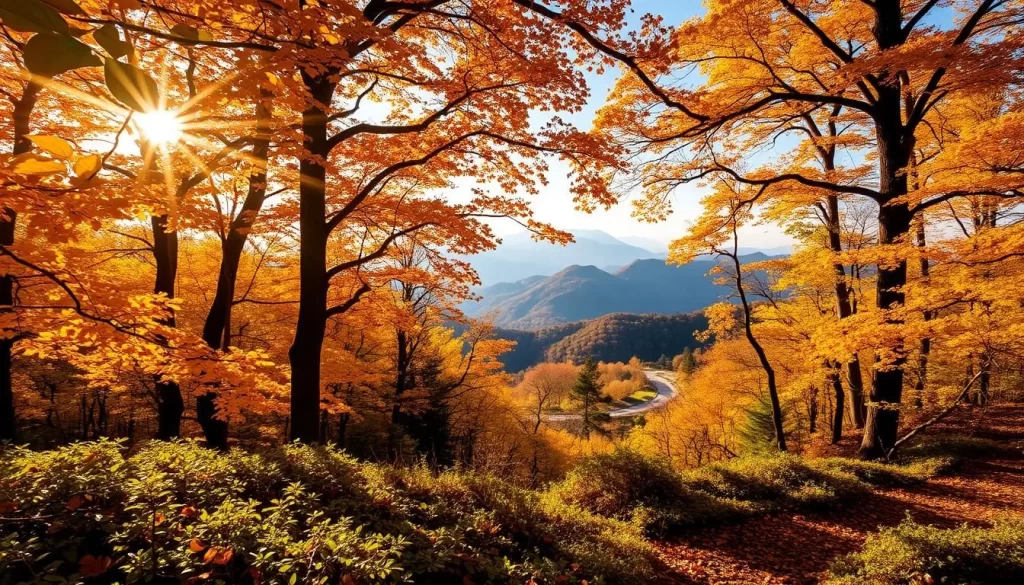
Weather Considerations and Crowd Patterns
Summer brings warmer weather, with temperatures soaring between 25°C and 30°C. While the trails are lush, the heat and humidity can make hiking challenging. If you visit during this time, plan your hikes early in the day to avoid the midday sun.
Winter offers a quieter experience. Temperatures drop to between -5°C and 5°C, and the gentle slopes are often dusted with snow. This season is perfect for those who prefer solitude and don’t mind the cold.
| Season | Temperature Range | Highlights |
|---|---|---|
| Spring | 7°C to 20°C | Cherry blossoms, mild weather |
| Summer | 25°C to 30°C | Lush trails, early hikes recommended |
| Autumn | 10°C to 20°C | Vibrant foliage, comfortable hiking |
| Winter | -5°C to 5°C | Snow-covered slopes, fewer crowds |
For a less crowded visit, aim for weekdays or early mornings. This way, you can enjoy the peaceful contrast between the bustling city and the serene natural setting. For more insights on planning your trip, check out this guide on the best time to visit Seoul.
Additional Activities and Local Experiences
After a day of hiking, there’s more to explore around the area. From cozy cafés to specialty shops, the region offers a variety of ways to unwind and extend your adventure. Whether you’re looking for a quick bite or a unique souvenir, you’ll find plenty of options to enhance your visit.
Cafés, Restaurants, and Hiking Shops
Local cafés and restaurants are perfect for refueling after a long hike. Many spots near the entrances serve authentic Korean dishes, allowing you to savor the flavors of the region. For those who love to shop, specialty hiking stores offer gear and apparel to suit your outdoor needs.
Visitor centers provide detailed maps to help you locate these hidden gems. Whether you’re craving a warm bowl of bibimbap or need a new pair of hiking boots, these local spots add to the overall experience.
Nearby Attractions and Day Trip Ideas
Beyond the trails, the area is rich with cultural and historical sites. Nearby temples and fortresses offer a glimpse into the region’s past, making for a well-rounded day trip. These attractions are easily accessible and complement your outdoor adventure.
For more ideas, check out this guide on nearby attractions and activities. Whether you’re exploring a temple or enjoying local food, these experiences make your visit even more memorable.
Conclusion
This destination offers a perfect blend of adventure and culture, making it a standout choice for travelers. With its diverse trails, striking scenery, and rich heritage, it’s no wonder this area attracts millions of visitors each year. Whether you’re scaling granite peaks or exploring ancient temples, there’s something for everyone.
From leisurely walks to challenging hikes, the variety of routes ensures every skill level is catered to. The natural beauty and historical significance of this place make it a must-visit spot. Its accessibility from central locations adds to its appeal, making it easy to plan a trip that fits your schedule.
For more inspiration on exploring the region, check out this guide on things to do in Seoul. Whether you’re a nature lover or a history buff, this destination promises an unforgettable experience. Start planning your visit today and discover why it’s a favorite among locals and travelers alike.
The above is subject to change.
Check back often to TRAVEL.COM for the latest travel tips and deals.
Here are some Tours & Sightseeing suggestions that might pique your interests!
